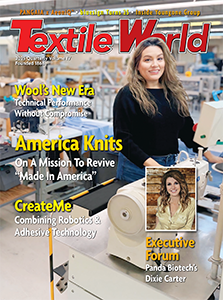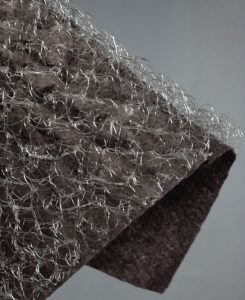
Enka® Solutions technology has been meeting diverse needs since the late 1960s.
TW Special Report
Every once in a while, the textile industry throws a curve in a positive kind of way. Maybe walking through the aisles of a show or expo, or maybe thumbing through an industry related magazine, a product or technology genuinely causes an abrupt stop with a desire to investigate further, only to find that it now creates more wonder and curiosity. Thoughts of “what is that,” “what’s it used for,” “how did they actually manufacture it” and maybe even “how can it be used in some application” start pinging around. Freudenberg’s Enka® Solutions technology is one of those unique and versatile product lines that has the ability to create this type of reaction.
Best described as a 3D nonwoven matrix structure generated from extruded polymeric filaments, Enka Solutions’ technology has been generating conversations and fulfilling various application needs since its development in the late 1960s. “It is a unique product technology with a virtually endless range of possibilities,” offered Audrey Sanders, business manager for Enka America. “The flexibility this technology provides to designers and engineers enables the creation of solutions for use in rather diverse market segments.”
Enka Solutions’ products are being produced both as private label products and also to be sold direct to customers. Global manufacturing locations now include Asheville, N.C., Obernburg, Germany, and Changzhou, China. The list of market segments for this technology currently includes filtration, composites, building and construction, civil engineering, green roofing, and sports and recreation, with more segments and applications in development or under consideration on a daily basis.
Enka’s Path To Present Day
The Enka name and brand has a long and storied history globally as well as in the American textile industry. Enka is derived from the initials of the organization’s original founding company, the Netherlands-based firm Nederlandse Kunstzijdefabriek (N-K), which translates as Dutch Artificial Silk Factory, which was founded in 1911 in Arnhem.
The American Enka Co. was established in Candler, N.C., just outside of Asheville, in 1928, providing N-K a base to expand into the growing American textile industry. It began as a manufacturer of rayon yarn before transitioning into producing nylon 6 in the 1950s.
While N-K is no longer in business, the Enka name has carried on. After a succession of different corporate ownerships and name changes, Enka was acquired by Low and Bonar in the mid-2000s. The Germany-based Freudenberg Group then acquired the Low and Bonar assets in 2020 positioning the Enka products as a brand under the Freudenberg Performance Materials (FPM) segment. According to Sanders, who has been with the company for more than 17 years and is happy that they are now part of FPM, “Freudenberg provides us with the stability and direction to invigorate, grow and build upon these technologies along with the freedom to make a deeper dive into our existing product offerings while also exploring new opportunities.”
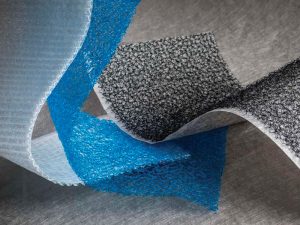
A Highly Adaptable Technology
“It really is a highly engineerable and adaptable technology,” stated Lori Hascher, Enka Technology’s research and development manager. “We have the ability to alter most any parameter or characteristic in the material, including the mesh shape and structure, interaction of the extruded filaments, the polymer composition and physical characteristics as the application may require.” The 3D structures can be produced in thicknesses ranging from 1 millimeter (mm) — 1/32-inch — to more than 50 mm — approximately 2-inches — with void spaces of up to 95 percent. A selection of standard and customized shape profiles are available as the molds used in the 3D matrix manufacturing process are created in-house. Polymer options include polyamide, polypropylene and polyester with others always in consideration. “Numerous additives are available to improve parameters through the polymer compounders we work with,” Hascher added.
In addition, the manufacturing process allows for the inclusion of “skins” applied to the face, back or both surfaces of the 3D matrix. These skins can be in the form of a nonwoven material, woven or knit fabrics and/or membranes to impart even more characteristics or functionalities towards the application’s requirements.
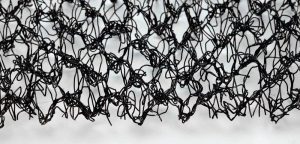
Diverse And Growing List Of Applications
Most 3D textile structures remain somewhat unique to the industry, but in general have gained acceptance in a number of technical and performance driven applications in countless facets of industry (See “3D Textiles: The Difference is Depth”, TW, July/August 2016). “It certainly can be challenging given the variety of applications this technology serves,” suggested Luca Quinones, product manager and inside sales. “One minute we’re speaking with a customer on soil stabilization and the next you might be discussing roof venting or spacer inclusion applications. It can make for interesting and varied conversations.”
There are several examples of Enka 3D matrix products and applications that may not generally be considered traditional textile applications.
- Building and Construction:
— EnkaSonic is a family of products used as a cushioning layer installed between flooring — such as hardwoods, engineered wood flooring and tiles — and the sub-floor of the building, which is usually concrete. EnkaSonic’s formation acts as a cushioning layer for the flooring that also provides a level of sound control. According to Sanders, a new customer is currently using a variation of this product in a layered system being used to deaden the sometimes-annoying sounds coming from indoor and outdoor pickleball courts when in use. - Ventilation Systems:
— EnkaExFlo is a unique construction designed to fold over the peak or ridge of a roof structure and allowing for proper ventilation along the ridge without letting unwanted moisture from rain or blowing snow to enter the ceiling structure. - Water Management:
— Variations of the Enka technology can be used to improve water management from within or outside building structures to safely redirect and improve water drainage from roofs or areas subject to pooling. - Civil Engineering:
— Erosion Control applications make use of Enka Solutions products as a protective layer for soil stabilization on slopes and embankments, waterways and shorelines. It can also be used to protect riverbanks, spillways and drainage areas from erosion caused by waterflow. Given its high level of void space, the 3D products can also help to establish vegetation in these applications.
— EnkaDrain refers to a multi-functional material construction that provides a proven reliable alternative for earthwork drainage of embankments, dykes and slopes as well as for reinforced walls. Its high shear strength and pressure resistant design can help to minimize construction time and reduce the localized environmental impact. - Green and Blue Roofing Systems
— Variations of the 3D matrix, generally with skins applied to one or both sides can be incorporated into green and blue roofing systems as a carrier for vegetation as well as to facilitate water management and mimic natural hydrology aiding in plant growth, easy harvesting and installation in rather unlikely environments. - Other Applications: Composites Manufacturing:
— EnkaFusion and EnkaChannel are two products being used as aids for the manufacturing of molded composite parts using vacuum infusion and resin transfer molding processes. Both products are compatible with most commonly used resin systems. EnkaFusion is employed as a flow media that as the name implies encourages the quick and even spread of resin across the width and breadth of the part being molded resulting in more even and consistent infusion. While EnkaFusion is designed to spread the resin flow, EnkaChannel was created to specifically provide a channel for the resin to flow efficiently and more directly to specific targeted locations. It is available in two widths and generally used in conjunction with larger molded part sizes such as boat hulls and wind turbine blades.
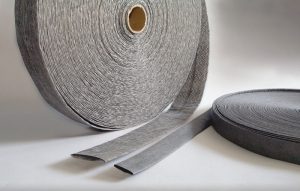
Benefiting from the newly found stability as part of the Freudenberg Group, Sanders has been reevaluating the Enka business segments and market opportunities with a view towards the future. “We’ve learned from the building industry that it is really important to be developing and providing the precise tools for each business segment and its associated applications,” she said. “So, we’re working hard to add the right products into our portfolio. We want to be closer to the market and end user to make sure we’re developing the products optimized to meet those needs in North America and globally.”
Given the broad diversity of potential applications for this technology and continued interest in those that create more wonder and curiosity, there is sure to be no short-age of viable opportunities for Sanders and her group to pursue.
2025 Quarterly Issue III

